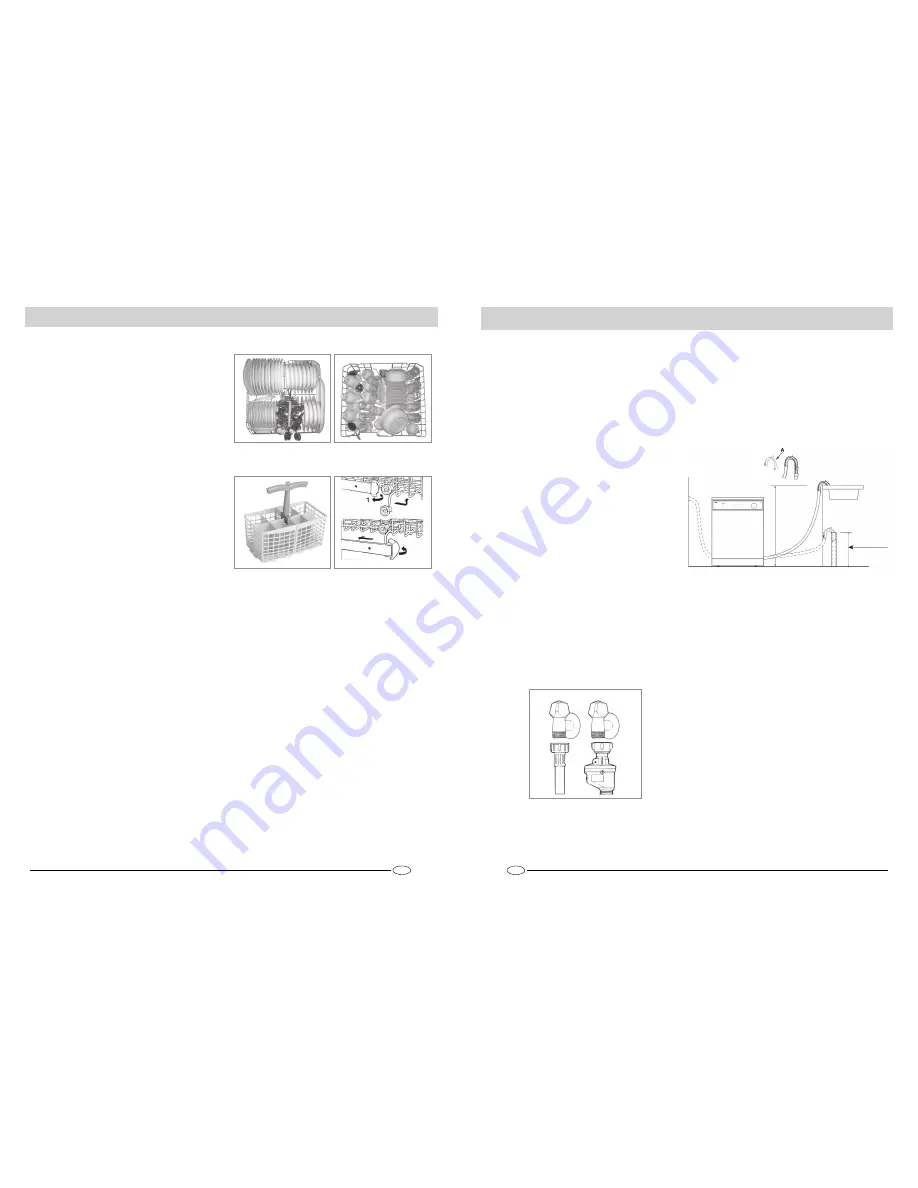
Installation
Positioning the Appliance
Position the appliance in the desired location. The back should
rest against the wall, and the sides along the adjacent cabinets
or wall. The dishwasher is equipped with water supply and drain
hoses that can be positioned to the right or left to facilitate proper
installation.
Levelling the Appliance
Once the appliance is positioned, adjust the feet (screwing them
in or out) of the dishwasher until it is level. In any case, the appli-
ance should not be inclined more than 2
°
. If the appliance is level,
it will help ensure proper performance.
Cold Water Connection
Connect the cold water supply hose to a threaded 3/4 (gas) con-
nector and make sure that it is fastened tightly in place (see fig.
1).
If the water pipes are new or have not been used for a prolonged
period of time, let the water run to make sure that the water is
clear and free of impurities. If this precaution is not taken, there is
a risk that the water inlet can get blocked and damage the
appliance.
Hot Water Connection
The water supply to the appliance can also be connected to the
house's hot water line (centralised system, heating system), as
long as it does not exceed a temperature of 60
°
C.
In this case, the wash cycle time will be shortened by about 15
minutes and the wash efficiency slightly reduced.
The connection must be made to the hot water line following the
same procedures as for the connection to the cold water line.
Drain Hose Connection
Insert the drain hose into a drain pipe with a minimum diameter
of 4cm, or let it run into the sink, making sure to avoid bending or
crimping it. Use the special plastic support that comes with the
appliance (see fig .2). The free end of the hose must be at a
height between 40 and 100 cm and must not be immersed in
water.
Attention:
The special plastic hose support must be solidly fastened to
the wall to prevent the drain hose from moving and allowing
water to spill outside the drain.
Electrical Connection
After making sure that the voltage and frequency values for the
current in the home correspond to those on the rating plate
(located on the stainless steel inner door of the appliance) and
that the electrical system is sized for the maximum voltage on
the rating plate, insert the plug into an electrical socket which is
earthed properly (the earthing of the appliance is a safety re-
quirement mandated by law).
If the electrical socket to which the appliance must be connected
is not appropriate for the plug, replace the plug rather than using
adaptors or the like as they could cause overheating and burns.
fig.2
.10.
GB
fig.1
MAX 100
MIN 40
.45.
ES
Carga del lavavajillas
Antes de colocar la vajilla en el lavavajillas, quite las partículas de
comida más grandes para evitar que se obstruya el filtro y se
reduzca el rendimiento.
Si las cazuelas y sartenes contienen comida incrustada difícil de
eliminar, póngalas a remojo antes de lavarlas. De este modo se
evitan los programas de lavado adicional. Extraiga el cesto para
facilitar la carga del lavavajillas.
Uso del cesto inferior
Coloque la vajilla más sucia en el cesto inferior: cazuelas, sartenes,
tapas, fuentes de servir y cuencos, como se muestra en la figura
situada a la derecha.
Es mejor colocar las fuentes de servir y las tapas en los laterales
del cesto para evitar que bloqueen el brazo aspersor superior.
- Coloque las cazuelas, fuentes de servir, etc. boca abajo.
- Coloque las cazuelas altas inclinadas para que el agua pueda
fluir.
- La cesta de los cubiertos es doble (vea la Fig. A); por tanto,
puede utilizarse sólo la mitad cuando haya pocos cubiertos.
Esto permite ampliar el espacio disponible para las cazuelas y
las sartenes en el cesto inferior.
- Coloque los cubiertos en el cesto correspondiente con los man
gos hacia abajo; si el cesto posee cestas laterales, coloque las
cucharas de forma individual en las ranuras correspondientes.
Coloque los cubiertos largos en horizontal en la parte exterior
del cesto superior.
Uso del cesto superior
El cesto superior está diseñado para contener la vajilla más
delicada, por ejemplo vasos, tazas y platos de café, además de
platos normales, pequeños cuencos y cazuelas poco profundas
(siempre que no estén muy sucios).
Coloque la vajilla y las ollas y sartenes de manera que no se
muevan con el chorro de agua.
Se puede regular la altura del cesto superior mediante los botones
laterales (vea la Fig. B).
Cesto inferior
Cesto superior
Carga estándar de 12 servicios
2
1
3
4
Fig.A
Fig.B












































